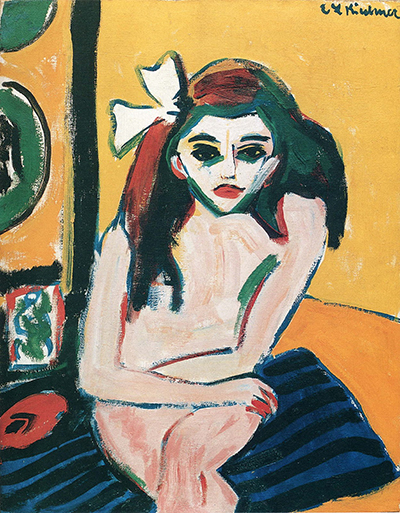Marzella was painted a number of times by members of the Die Brücke art movement, and this one by Kirchner is perhaps the most memorable. This small painting was completed in 1909-1910.
The style of this portrait is typical of Kirchner - from the bold, contrasting colour scheme to the dark lines which define form. The face is also constructed from blocks of colour, rather than attempting to blend everything together. The girl features an interesting combination of innocence and youthfulness, but also alluring eyes and bright lips. Her pose is of vulnerability, she leans over with her arms crossed and her legs together. She sits on a small striped carpet or towel and the colours to fill the room behind her are bright and warm, with again very minimal detail. The work is clearly Expressionist, where artists concentrate on feeling and emotion rather than directly reproducing reality.
An interesting comparison can be made between Marzella and Puberty, by Edvard Munch in 1894-1895. Both artists used expressive styles in their work and concentrated less on detail than in expressing themselves in their work. Kirchner's work here is cropped, so that we do not see the model in full length. Her facial expression is more neutral and harder to decipher than as compared to the Norwegian's portrait. Kircher's work is now owned and on display at the Moderna Museet Stockholm, in Sweden. This institution also contains work by Pablo Picasso, Salvador Dalí, Georges Braque, Juan Gris, Rene Magritte and Paul Klee.
The Die Brücke movement had been running for around 5 years by the time of this painting and there was a clear identity to this group of artists already - from the contrast of light and dark colours to the jagged portraiture. These forward-thinking artists would run into significant trouble from German authorities who disapproved of their modern approach and much preferred more traditional types of art. This kind of clash is normal, but the unique factor here was that the Government would not just condemn the work, but they actually went as far as confiscating, even destroying some of it.




